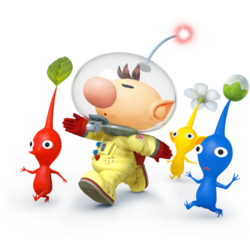- This article is about Olimar's appearance in Super Smash Bros. 4 . For other uses, see Captain Olimar and Pikmin (species).
| Olimar in Super Smash Bros. 4 | |
|---|---|
 
| |
| Universe | Pikmin |
| Other playable appearance | in Brawl |
| Availability | Starter |
| Final Smash | End of Day |
Olimar, known on the website and the Japanese version of the game as Pikmin & Olimar, was announced to be returning for Super Smash Bros. 4 on July 12th 2013 on the game's official website, and was the first character revealed after the initial E3 2013 reveal of Smash 4. His reveal came one day before the release date of Pikmin 3 in Japan, which Masahiro Sakurai noted in a Miiverse post. A link to the official website on Pikmin 3 is at the bottom of his page on the website. He retains Red, Yellow, Blue, White, and Purple Pikmin. Olimar has had slight aesthetic changes to match his Pikmin 3 character design, and a visible whistle is now a part of Olimar's helmet. The Pikmin have been updated as well with different proportions more akin to Pikmin 3.
Changes from Brawl
- Thrown Pikmin can carry items to Olimar. [1]
- Pikmin are now plucked in a set cycle (Red, Yellow, Blue, White, Purple, Red, Yellow, Blue, White, Purple, etc.), instead of being random.
- Up air is a single hit which gives it better juggling and kill potential.
- There are now indicaters showing which Pikmin will be thrown next, allowing the player to know which attacks to use.
- Foward tilt is now a powerful punch.
- End of Day's final explosion has a greater hitbox.
- Down tilt has been strengthened.
- Pikmin fly much farther when thrown.
- However, this makes them more vulnerable to falling off stages.
- Some of Olimar's attacks (forward aerial, back aerial, up smash, down smash) have been sped up.
- However, his up smash has slightly decreased vertical range.
- Forward smash's reach has been extended.
- However, its KO potential and damage outputs have been reduced slightly.
- Pikmin no longer fall of the stage when it is used on the edge of the stage
- Olimar has a new up special recovery move, using Winged Pikmin instead of Pikmin Chain. These Pikmin can carry Olimar to great heights.
- However, Olimar must carry fewer Pikmin with him to gain more distance, whereas in Brawl he needed more Pikmin. This means Olimar will have to sacrifice Pikmin to recover better.
- Jab combo deals less damage than in Brawl. (15% to 7%.)
- Olimar is lighter than in Brawl.
- Pikmin Order no longer grants Olimar a brief period of super armor at the start.
- Olimar will now only be able to carry three Pikmin at a time after using Pikmin Pluck (unlike in Brawl, where he could carry up to six).
- Red Pikmin deal slightly less damage than in Brawl.
- Pikmin appear to be slightly larger; Olimar's size appears mostly unchanged.
- The Pikmin at the head of the line has a player-coloured pointer above their head, as do Pikmin at a distance from Olimar.
- Forward tilt and jab combo now consist of punches which are based on the Rocket Fist technique from Pikmin 2.
- In the 3DS version, Pikmin cannot have their leaves turned into flowers or buds.
The following moves are visually unchanged from Brawl:
Special Moves
In Super Smash Bros. 4, special moves can be swapped out for different variants. He retains three of his original special moves and his final smash. Pikmin Chain has been replaced with a more effective recovery utilizing Winged Pikmin. These are Olimar's special moves:
| Special Move | Basic | Custom 1 | Custom 2 |
|---|---|---|---|
| Neutral Special | Pikmin Pluck | Hardy Pikmin Pluck | Explosive Pluck |
| Side Special | Pikmin Throw | Speedy Pikmin | Butterfinger Pikmin |
| Up Special | Winged Pikmin | Winged Pikmin Jump | Mighty Winged Pikmin |
| Down Special | Pikmin Order | Crash Whistle | Shrill Whistle |
| Final Smash | End of Day | ||
Palette Swaps
Gallery
Pikmin looking up at Kirby.
A screenshot of Olimar's Pikmin near Mega Man.
Wii Fit Trainer and Olimar on in the Wii Fit Stage.
The Hocotate Bomb.
Olimar uses his new recovery move, the Winged Pikmin.
References
| Fighters in Super Smash Bros. 4 | |
|---|---|
| Veterans | Bowser · Captain Falcon · Charizard · Diddy Kong · Donkey Kong · Dr. Mario · Falco · Fox · Ganondorf · Ike · Jigglypuff · King Dedede · Kirby · Link · Lucario · Lucas · Luigi · Mario · Marth · Meta Knight · Mewtwo · Mr. Game & Watch · Ness · Olimar · Peach · Pikachu · Pit · R.O.B. · Roy · Samus · Sheik · Sonic · Toon Link · Wario · Yoshi · Zelda · Zero Suit Samus |
| Newcomers | Bayonetta · Bowser Jr. · Cloud · Corrin · Dark Pit · Duck Hunt · Greninja · Little Mac · Lucina · Mega Man · Mii Fighter (Mii Brawler · Mii Gunner · Mii Swordfighter) · Pac-Man · Palutena · Robin · Rosalina & Luma · Ryu · Shulk · Villager · Wii Fit Trainer |
| Pikmin universe | |
|---|---|
| Fighter | Olimar (SSBB · SSB4 · SSBU) (Pikmin) (Alph) |
| Assist Trophy | Burrowing Snagret |
| Stages | Distant Planet · Garden of Hope |
| Item | Hocotate Bomb |
| Enemies | Bulborb · Iridescent Glint Beetle |
| Other | Hocotate Ship · Peckish Aristocrab · Pellet · Plasm Wraith · Yellow Wollywog |
| Trophies, Stickers and Spirits | Trophies (SSBB · SSB4) · Stickers · Spirits |
| Music | Brawl · SSB4 · Ultimate |
